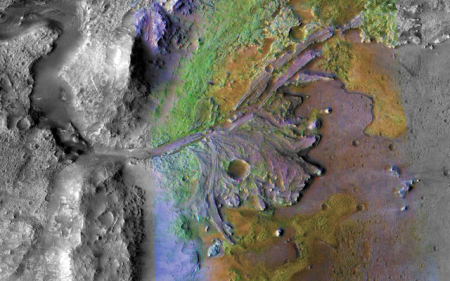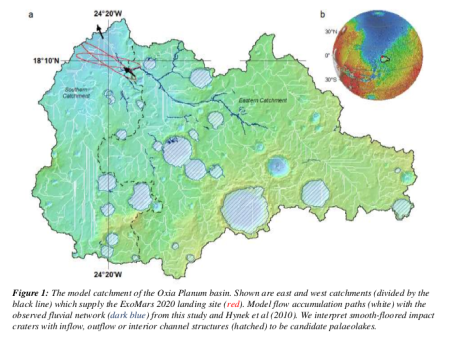Jezero Crater: The landing site for the Mars 2020 rover

Jezero Crater delta
At this week’s 50th Lunar and Planetary Science Conference in Texas, there were many papers detailing the geological, topographical, chemical, meteorology and biological circumstances at the landing sites for the 2020 Martian rovers, Jezero Crater for the U.S.’s Mars 2020 and Oxia Planum for Europe’s Rosalind Franklin.
Most of these papers are a bit too esoteric for the general public (though if you like to delve into this stuff like I do, go to the conference program and search for “Jezero” and “Oxia” and you can delve to your heart’s content).

These papers do make it possible to understand why each site was chosen. I have already done this analysis for Rosalind Franklin, which you can read here and here. Oxia Planum is in the transition between the southern highlands and the northern lowlands (where an intermittent ocean might have once existed). Here can be found many shoreline features. In fact, one of the papers at this week’s conference mapped [pdf] the drainage patterns surrounding the landing ellipse, including the water catchment areas, as shown by the figure from that paper on the right.
With this post I want to focus on Jezero Crater, the Mars 2020 landing site. The image above shows the crater’s most interesting feature, an impressive delta of material that apparently flowed out of the break in the western wall of the crater.
This image however does not tell us much about where exactly the rover will land, or go. To do that, we must zoom out a bit.

The annotated image on the left was created from two images taken by the context camera on Mars Reconnaissance Orbiter (MRO), found here and here. The white box shows you the location of the first image above. The black ellipse shows you the landing area for Mars 2020. Their plan is to land on the flat crater floor to the east of that delta. From there it is quite clear from all of this week’s papers that the goal will be to then drive west and up onto that delta. (For scale, I estimate based on another image of the delta that the distance across the delta from its head to the rim to be between three to five miles.)
If this rover lasts as long as designed, it will hopefully even be able to travel up beyond the delta into the break in the crater wall and into the drainage valley beyond. In anticipation of this, one paper this week [pdf] even mapped the watershed above the crater. Any water in that watershed would have drained into the crater to form a lake there, which in turn would have drained to the east out into the northern lowlands.

As with almost all past landers/rovers, the scientists here have chosen a location in the transition zone between the northern lowlands and the southern highlands, as shown in the overview to the right. This gives them the best location for quickly seeing a wide variety of geology. Moreover, the delta will also contain material from the west, increasing the range of data they can quickly gather.
This location however is not necessarily the best for future human exploration or colonization. It might contain water, but this is not obvious. The delta itself might be a form of mud, which one paper [pdf] this week suggested would flow almost like lava on Mars. If so, there might be water in it.
Other sites, however, have far greater potential both for water and for building a good initial colony. As I have noted previously, our exploration strategy on Mars has so far been dominated almost entirely by scientific concerns, which while very important and essential, do not always coincide with exploration and settlement concerns.
As our knowledge grows, however, and the competition to get to Mars increases, the focus will shift. Once the first human missions are just over the horizon, the need to explore good colony locations will become primary, and the unmanned scouting missions will start heading that way.
In the meantime, the journeys that will occur in Jezero and Oxia beginning in 2020 will be more than spectacular. There will be no need to complain from an explorer’s perspective.
On Christmas Eve 1968 three Americans became the first humans to visit another world. What they did to celebrate was unexpected and profound, and will be remembered throughout all human history. Genesis: the Story of Apollo 8, Robert Zimmerman's classic history of humanity's first journey to another world, tells that story, and it is now available as both an ebook and an audiobook, both with a foreword by Valerie Anders and a new introduction by Robert Zimmerman.
The print edition can be purchased at Amazon or from any other book seller. If you want an autographed copy the price is $60 for the hardback and $45 for the paperback, plus $8 shipping for each. Go here for purchasing details. The ebook is available everywhere for $5.99 (before discount) at amazon, or direct from my ebook publisher, ebookit. If you buy it from ebookit you don't support the big tech companies and the author gets a bigger cut much sooner.
The audiobook is also available at all these vendors, and is also free with a 30-day trial membership to Audible.
"Not simply about one mission, [Genesis] is also the history of America's quest for the moon... Zimmerman has done a masterful job of tying disparate events together into a solid account of one of America's greatest human triumphs."--San Antonio Express-News


what is gained from sending people to Mars compared to sending an equal size payload and number of missions carrying rovers and other remotely operated equipment? Even sending people to the Moon … does that accomplish much compared to what a rover or digger could do? The payload required to support people and then return them safely – must be very large.
@Steve Richter
A rover on Mars is sent a batch of commands once a day. Then it moves a few meters, next day it drills a few centimetres into the ground. What does a geologist do during a day in the field with a hammer in hand? A human being is enormously much more efficient than a robot. Perhaps that will change in the future, but this is NASA and they spend billions of dollars on that thing. So I wouldn’t challenge to better them (unless I were on site).
Look at the Insight lander that cannot put its thermometer into the ground. A man on site would say, oh, that’s the rub, and fix the problem in a minute. Now they are helpless.
Steve Richter: Others have given the practical reasons for sending humans to Mars (and elsewhere). Let me give you the philosophical one: Why should robots have all the fun?
Humans like to explore. The robots are our first attempts, our scouts, for visiting these other worlds. They are not the end all, and never should be. They lay the groundwork for humans to follow, with joy and excitement.